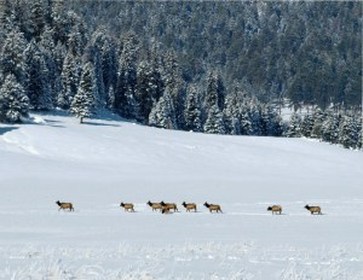 Elk foraging on a winter day
Elk foraging on a winter day Here I sit in the early pre-dawn with a cozy fire in the woodstove. But just outside our little mountain getaway cabin yesterday at this time lay a herd of over fifty elk, curled onto the snow with the temperature below zero. How can they do that?
Elk (Cervus elaphus) are the next-to-largest cervid of North America (moose is largest) with males weighing in around 700 pounds and standing five feet at the shoulder. They are herd animals but the composition of the herd changes seasonally. This time of the year, the rut (mating season) is over and cows, bulls and juveniles mix more freely without the contention and noise of two months ago. Larger herds–in this area around 50-200 animals–range over the mountains looking for areas with open sunshine where snow may be thinner, allowing them to find the grasses and low forbs that are their normal, summer forage. As the snow deepens, their diet changes to include more brush and “browse” including a lot of aspen twigs and bark (see previous blog).
Elk (Cervus elaphus) are the next-to-largest cervid of North America (moose is largest) with males weighing in around 700 pounds and standing five feet at the shoulder. They are herd animals but the composition of the herd changes seasonally. This time of the year, the rut (mating season) is over and cows, bulls and juveniles mix more freely without the contention and noise of two months ago. Larger herds–in this area around 50-200 animals–range over the mountains looking for areas with open sunshine where snow may be thinner, allowing them to find the grasses and low forbs that are their normal, summer forage. As the snow deepens, their diet changes to include more brush and “browse” including a lot of aspen twigs and bark (see previous blog).
Elk have long, strong leg bones and most of their mass is carried up out of the snow. So their tracks in 1-2 foot of snow are mostly long, dragging steps which sink deeply, easily visible from long distances on the surrounding slopes of otherwise untracked snow. They have larger hooves and take a considerably longer step than our Mule deer. Like human snowshoers, they will often play follow-the-leader as it’s easier to use a “broken” trail through deep snow. But their trails look like you might expect of browsing shoppers unsure of their ultimate destinations but trending toward certain departments, each diverting this way and that, stopping occasionally to sample something to eat, or going around obstacles before re-joining the group.
Their winter body hair is coarse and stiff, but the individual hairs are pithy or hollow with trapped air. This specialized hair and the undercoat hair (which is finer and much softer), help keep them warm even in below zero weather. During snowstorms, it is not uncommon to see elk with snow on them, unmelting until the storm ends and the sun returns. And their heavy coats allow them to curl up rather dog-like into snowbanks with their feet tucked up underneath themselves making their own personal snow forts. In this position, they can actually stay warmer and snooze with the snow acting as windbreak and insulation.
I love my creature comforts and could not survive without artificially added layers and warmth. But the elk do very well without, thank you!
Their winter body hair is coarse and stiff, but the individual hairs are pithy or hollow with trapped air. This specialized hair and the undercoat hair (which is finer and much softer), help keep them warm even in below zero weather. During snowstorms, it is not uncommon to see elk with snow on them, unmelting until the storm ends and the sun returns. And their heavy coats allow them to curl up rather dog-like into snowbanks with their feet tucked up underneath themselves making their own personal snow forts. In this position, they can actually stay warmer and snooze with the snow acting as windbreak and insulation.
I love my creature comforts and could not survive without artificially added layers and warmth. But the elk do very well without, thank you!


 RSS Feed
RSS Feed
